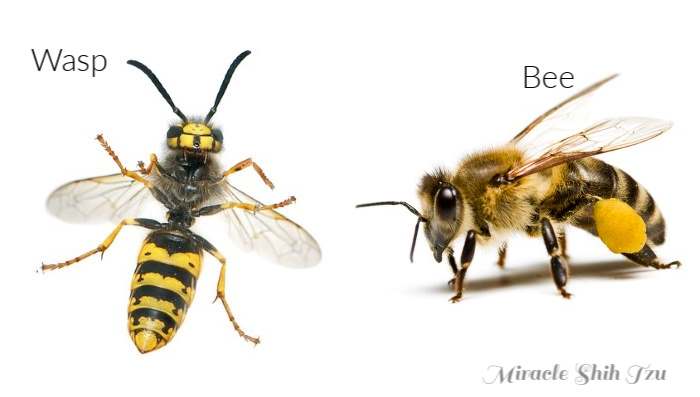Treating Bee Stings in Dogs: Your Shih Tzu Will Appreciate Your Help
Bee Stings in Dogs By Rae Hudson |Last Updated 10-08-2020
Dogs are known to be curious by nature, and there is almost nothing which does not catch their interests. Insects particularly are objects of interests, and dogs are known to investigate them, by sticking their nose and head where they are not meant to be. Sometimes, they get unlucky, and they get hurt in the process. They can get stung by insects.
Types of Bee Stings in Dogs
 Wasp and Bee Stings in Dogs
Wasp and Bee Stings in DogsNow, bee stings, especially, are usually painful for the curious dog and could cause all sorts of unimaginable problems. Besides the pain and irritation to the skin, a sting could cause an allergic response that requires an immediate trip to the veterinarian.
Two types of insects inflict stings, bees, and wasps. Both inject a small amount of poison which causes most of the problems. Bees die after stinging because it’s stinger lodges into the skin of its victim. Wasps are more dangerous because they do not die and thus can sting many times.
How to Know If Your Dog Has Been Stung
There are a few behaviors that dogs will do if they are stung by a bee or bitten by another type of insect.
- Licking or biting at his paw
- Pawing at the face
- Swelling, Redness at the site of the sting
- Drooling
- Yelping or Crying
If you notice any of these, suspect that your dog has been stung. If your dog has never encountered a bee or wasp, you won't know what type of reaction to expect. Just as in humans, dogs can suffer from anaphylactic shock if he is severely allergic. This is an emergency and you will know shortly after he has been stung because he will have difficulty breathing, develop hives, severe swelling, shock and problems with coordination.
Common Location of Bee Stings on Dogs
Since dogs explore with their noses, the most likely place for them to get stung is on their face or even their nose. Some dogs even try to snap at the bees, which often results in a sting to their tong or inside of their mouth.
This is particularly problematic because the swelling that results from the bite can block his airway or his throat. If you notice that your dog is having difficulty breathing, has become irritated or lethargic, or is showing signs of stress, take him to a veterinary emergency hospital. Treat this as a medical emergency.
First Aid Supplies For Bee Stings on Dogs
 First Aid for Bee Stings in Dogs
First Aid for Bee Stings in DogsWhat should be in a first aid kit?
A basic first aid should contain necessary supplies such as gauze pads, tape, scissors, antibiotic solution, bandages, and a first aid manual. First aid kits are not hard to put together, or if you prefer, you can purchase a ready-made one. For bee stings in dogs, your first aid supplies will be a little different. To be prepared for a sting or insect bite, there are a couple of additional items to add to your first aid kit.
- Baking soda
- Aloe Vera
- Epson Salts
- Witch Hazel
- Credit card or cardboard to remove the stinger
Remove the Stinger if Possible
Use the side of a credit card to scrape the stinger off of your dog. Don’t use tweezers because squeezing the stinger can cause more poison to enter the body from the sac of the stinger.
Here are various first aid measures which are quintessential after the stinger is removed
Baking Soda Paste For Treating Bee Stings on Dogs
Baking soda paste is one of the best and effective way of ensuring that your dog gets some relief. The application of baking soda paste to the sting is very easy. All you need to do is, mix a tablespoon of baking soda with enough water to form a paste.
Apply it to the affected area. There is no need to apply the whole paste at once. This method is known to be a safe and productive one which would go a long way in ensuring that your dog gets back quickly on his feet.
Aloe Vera Application for Bee Stings in Dogs
Aloe Vera is notable for its amazing properties when it comes to giving the skin, a soothing feeling. Besides the fact that it helps in reducing the pain, it also reduces swelling.
Aloe Vera also helps in treating sunburns, and in the same vein helps to relieve the pain that comes with bee stings. Ensure the Aloe Vera used is pure and devoid of products such as chemicals or alcohol.
Epsom Salts for Bee Stings on Dogs
In humans, Epsom salt is known to bring relief, and it can also make a dog feel better if he gets stung by a bee. There are two obvious ways to use Epsom salt for treating bee stings. They are spot and bathing application.
For spot application, dissolve one tablespoon of Epsom salt in a cup of warm water, then use a cotton ball and apply to the sting. You can carry this out for as long as possible, till the swelling reduces.
For the bathing application, it is quite simple. You would need to dissolve one tablespoon of Epsom salt in two cups of water and ensure he is bathed with this mixture. The salt would aid in soothing his already-irritated skin, along with easing tension and pain.
You can apply witch hazel several times. Once the swelling and the irritation subside, you can be sure that the witch hazel has done its job.
Ice Pack Application for Bee Stings in Dogs
This is one effective way of helping your dog out when they are stung by bees. An ice pack is very efficient in reducing swellings and the pains which comes with the bee sting. What you need to do is, apply a wrap to the sting. Also, wrap the ice in a towel, and apply carefully to the bite.
However, you should be aware of the fact that not all dogs like ice packs. You need to be wary of this, and make provision for a backup treatment in case your dog does not like it.
More Ideas for Treating the Pain
If these home remedies do not help calm your dog and relieve his pain, you may want to consult a veterinarian. There is quite a few pain medicines on the market today to treat pain in dogs. If there is inflammation, then there is likely pain, so you don't want your dog to suffer. The younger dogs and those that have tiny Shih Tzu should be the most worried about a dog in pain because the shear volume of venom received by the bee in proportion to body weigh is much greater.
Precautions When Treating Bee Stings on Dogs
First off, ensure your dog does not irritate the sting. This is important during first aid. When the healing is in motion, there is a tendency for itching to take place, and when the dog responds accordingly, it could prolong the healing process.
Also, make sure you watch out for the symptoms which could occur some days after the sting. Poor appetite or refusing food altogether is not uncommon. Also, drinking water may be difficult and when a dog does not get enough water, they can become dehydrated very quickly. Always be ready to ensure that you make a prompt visit to the vet if the symptoms do not subside.
Lastly, make sure your dog gets a comfortable place to rest. The effects of the sting could induce depression, irritation, and exhaustion. Hence, resting is essential for the dog.
Conclusion
Innately, dogs are very agile, curious, and alert animals. Hence, if any discomfort is brought to them, it is easily noticeable. A Bee sting has a way of inducing great discomfort to your dog, which could keep them itching all day long. As a dog owner, you need to be ready when issues like this occur, and you must combat it accordingly with efficient first aid techniques.
Author’s Bio: Treating Bee Stings in Dogs: Your Shih Tzu Will Appreciate Your Help
Rae is long-time pet owner: two cats and a dog. She graduated with a degree in journalism from a public university in Texas. I write about all things pets, including first aid, health issues, injuries, and nutrition.
About Janice
Janice is the voice behind Miracle Shih Tzu. Having lived with dogs and cats most of her life, she served as a veterinary technician for ten years in Maryland and twelve years as a Shih Tzu dog breeder in Ohio.
Her education includes undergraduate degrees in Psychology with a minor in biology, Early Childhood Education, and Nursing, and a master's in Mental Health Counseling.
She is a lifelong learner, a dog lover, and passionate about the welfare of animals. Her favorite breed for over 50 years has been the Shih Tzu.
When not writing, reading, or researching dog-related topics, she likes to spend time with her eight Shih Tzu dogs, her husband, and her family, as well as knitting and crocheting. She is also the voice behind Small Dog Place and smart knit crocheting.



